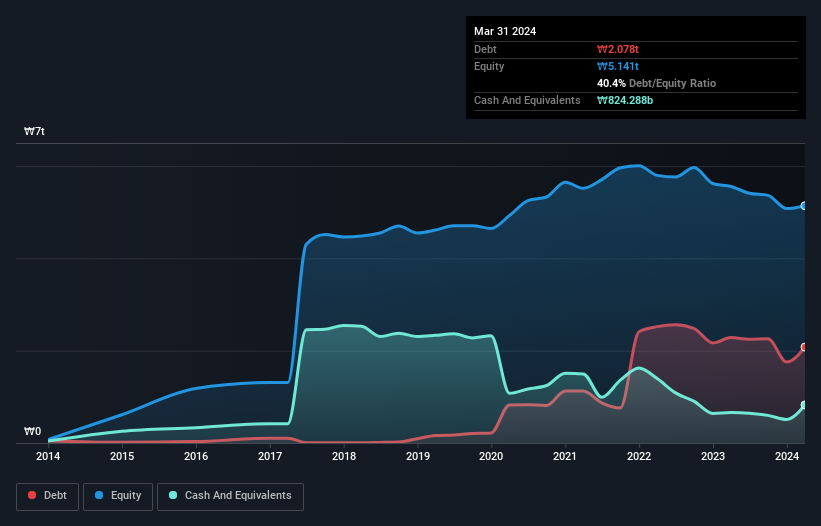Howard Marks put it nicely when he said that, rather than worrying about share price volatility, 'The possibility of permanent loss is the risk I worry about... and every practical investor I know worries about.' So it seems the smart money knows that debt - which is usually involved in bankruptcies - is a very important factor, when you assess how risky a company is. Importantly, Netmarble Corporation (KRX:251270) does carry debt. But the more important question is: how much risk is that debt creating?
When Is Debt A Problem?
Debt assists a business until the business has trouble paying it off, either with new capital or with free cash flow. Part and parcel of capitalism is the process of 'creative destruction' where failed businesses are mercilessly liquidated by their bankers. However, a more frequent (but still costly) occurrence is where a company must issue shares at bargain-basement prices, permanently diluting shareholders, just to shore up its balance sheet. Having said that, the most common situation is where a company manages its debt reasonably well - and to its own advantage. When we think about a company's use of debt, we first look at cash and debt together.
Check out our latest analysis for Netmarble
How Much Debt Does Netmarble Carry?
As you can see below, Netmarble had ₩2.08t of debt at March 2024, down from ₩2.28t a year prior. However, it does have ₩824.3b in cash offsetting this, leading to net debt of about ₩1.25t.

How Healthy Is Netmarble's Balance Sheet?
According to the last reported balance sheet, Netmarble had liabilities of ₩1.79t due within 12 months, and liabilities of ₩1.36t due beyond 12 months. Offsetting these obligations, it had cash of ₩824.3b as well as receivables valued at ₩270.0b due within 12 months. So its liabilities outweigh the sum of its cash and (near-term) receivables by ₩2.06t.
Netmarble has a market capitalization of ₩5.19t, so it could very likely raise cash to ameliorate its balance sheet, if the need arose. But it's clear that we should definitely closely examine whether it can manage its debt without dilution. When analysing debt levels, the balance sheet is the obvious place to start. But ultimately the future profitability of the business will decide if Netmarble can strengthen its balance sheet over time. So if you want to see what the professionals think, you might find this free report on analyst profit forecasts to be interesting.
Over 12 months, Netmarble made a loss at the EBIT level, and saw its revenue drop to ₩2.5t, which is a fall of 6.0%. That's not what we would hope to see.
Caveat Emptor
Importantly, Netmarble had an earnings before interest and tax (EBIT) loss over the last year. To be specific the EBIT loss came in at ₩64b. Considering that alongside the liabilities mentioned above does not give us much confidence that company should be using so much debt. So we think its balance sheet is a little strained, though not beyond repair. However, it doesn't help that it burned through ₩49b of cash over the last year. So to be blunt we think it is risky. For riskier companies like Netmarble I always like to keep an eye on the long term profit and revenue trends. Fortunately, you can click to see our interactive graph of its profit, revenue, and operating cashflow.
Of course, if you're the type of investor who prefers buying stocks without the burden of debt, then don't hesitate to discover our exclusive list of net cash growth stocks, today.
Valuation is complex, but we're here to simplify it.
Discover if Netmarble might be undervalued or overvalued with our detailed analysis, featuring fair value estimates, potential risks, dividends, insider trades, and its financial condition.
Access Free AnalysisHave feedback on this article? Concerned about the content? Get in touch with us directly. Alternatively, email editorial-team (at) simplywallst.com.
This article by Simply Wall St is general in nature. We provide commentary based on historical data and analyst forecasts only using an unbiased methodology and our articles are not intended to be financial advice. It does not constitute a recommendation to buy or sell any stock, and does not take account of your objectives, or your financial situation. We aim to bring you long-term focused analysis driven by fundamental data. Note that our analysis may not factor in the latest price-sensitive company announcements or qualitative material. Simply Wall St has no position in any stocks mentioned.
Have feedback on this article? Concerned about the content? Get in touch with us directly. Alternatively, email editorial-team@simplywallst.com
About KOSE:A251270
Netmarble
Develops and publishes PC, mobile, and console games in South Korea and internationally.
Adequate balance sheet with moderate growth potential.
Similar Companies
Market Insights
Community Narratives




